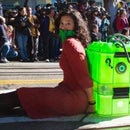Introduction: 3D Fab(ulous) Lipstick Case
I'm not a software engineer, and have never used a 3D modeling package. Personally, I'm much more of a hands-on girl, into car engines and machine tools. Physical things, in other words.
Lipstick is physical. The brand I use (probably shouldn't name it here, but you'll figure it out) is fantastic. High-quality, sassy, potent. The casings, however, are all sleek, identical, bland. When I'm using lipstick, it's because I'm being social and fun, and I want casings to match.
It's high time to customize my favorite accessory. I'm thinking old-school glamour, like vintage bejeweled compacts. The software element is a challenge, but one which can be mastered with a little creativity and the right lipstick.
Step 1: Intricate Patterns
The idea comes to me as a mash-up of the nested carved ivory balls (something that's impossibly intricate and obviously handmade) and the magician lace-makers from Eragon's Nasuada. The latter for me is how to get something that women would love to have from a technology that very few of them know how to use - namely 3D printing.
One of the amazing things about 3D printing is the ability to make shapes that are impossible, impractical, or at least prohibitively expensive for traditional manufacturing methods. Since I work in computer manufacturing, I at least have a reasonable grasp on the capabilities of traditional methods and none of them can accomplish what I want to do.
Step 2: Insert Software Genius Here
What I need out of the software is not just the right shape for the casing, but a way to iterate quickly on designs. I'm not going to spend a week moving vertices around every time I want a new design. My plan is to be able to kick out 5 new designs in a day. I'm going to draw each one, and let the tech handle the rest.
Being a mechanical engineer, not a software engineer, I don't have the capability to build my own 3D modeling tool from scratch and the available 3D modeling packages don't seem to have what I need for this. I started down the path of learning a 3D package but quickly got frustrated with trying to even express simple ideas, let alone the intricate images I had in mind.
Fortunately, I know a few geek boys. One in particular (instructables name: LabRat) had also already done a similar project, a tool for making models from images (see this insane Mazeball Padlock). He's reasonably good-looking and wickedly smart when it comes to 3D math. Getting him to take on a new side-project was even easier than I expected it to be. Find an excuse to have lunch, let him tell you about his project for a while, switch the topic to lipstick, and then eventually hint that you're wondering if his tool would be able to get the job done.
He seemed pretty sure it would. By the end of lunch, he was convinced he could get his software changed over in an afternoon. That wasn't entirely true. It took about two weeks. (Everything programmers do takes about two weeks, for some mysterious reason.)
Step 3: Digital Lipstick Case Outline
The shape of the lipstick case was actually captured using a digital camera and an Excel spreadsheet. Using this shape instead of the existing sphere cross-section, the software instantly kicked out a shape that was pretty close. This also gave me an idea where the part lines would need to be to separate the top and bottom parts of the case.
Step 4: Easy 2D Design Iterations
While my partner was refining the software, I experimented in Photoshop with the images that would form the basis of my lipstick cases. Since the 3D printers could handle printing as thin as 0.7mm, my creations became intricate filigrees. Using black and white images, where black was areas where the model would have holes, and white being the areas where the material would be the thickest, I finalized my designs using a decidedly 2D technology where I could rapidly iterate my ideas.
Step 5: Building the 3D Model
Now came the simplest part. Using LabRat's experimental shell-fab software (by now complete), I just pasted my design from Photoshop into the image window. In the second window, I could see how the shape wrapped around the lipstick casing, rotate it, zoom in or out, etc. Needing to make a few tweaks (like ensuring I got the right split on the top and bottom) was as simple as going back to Photoshop, editing the image, and pasting it back into the window.
News update: He's made a web-hosted version of the software. You can try it here: http://lipstick.machinelevel.com
Happy with my design, the software kicks out an STL file that I then uploaded to Shapeways. Having decided that metal, although cool, was much too expensive, I settle on various colors of the inexpensive plastics readily available from their website.
Step 6: Final 3D Fab(ulous) Fashion Accessory
About a week after purchasing the parts from Shapeways, various versions adorn my lipsticks. Given I used the Excel estimate for the curve of the case they fit reasonably well, but a few of them are a bit loose which is quickly solved by a dot of glue.
Not only can I tell them apart in my purse just by feel, but they provide color, texture, fun and flair to my personal favorite accessory! I've even posted a few to the Shapeways site for anyone who wants to try them out: http://machine-level.com/fab/shoplinks.php

Participated in the
Make It Real Challenge











